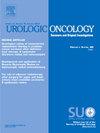Increase in workload among genitourinary oncologists drives burnout: Insights from the BUCARE survey
IF 2.4
3区 医学
Q3 ONCOLOGY
Urologic Oncology-seminars and Original Investigations
Pub Date : 2025-05-01
DOI:10.1016/j.urolonc.2025.03.019
引用次数: 0
Abstract
Background
Burnout is a significant issue among GU oncologists, driven by increasing workloads and the emotional demands of patient care. This study aims to identify the prevalence, risk factors, and potential interventions to address burnout in this population.
Methods
A comprehensive survey, including a visual mood assessment, was conducted among 674 GU oncologists. The survey assessed work conditions, mood, and burnout indicators, alongside demographic and professional characteristics.
Results
Among the respondents, 72% (482 out of 674) displaying symptoms of burnout, characterized by high emotional exhaustion and/or depersonalization. Key risk factors included long working hours (more than 8 hours per day for 54% of respondents), high patient volumes (48% managing over 15 patients daily), and night shifts (16%). Despite signs of burnout in 72% of participants, a visual mood assessment showed that 72% reported being in a good or excellent mood. Additionally, 92% of respondents expressed passion for their work, and 84% showed a strong desire for professional development.
Conclusions
Burnout is prevalent among GU oncologists, despite their dedication to their profession. Strategic interventions, such as expanding the workforce and reducing daily patient volumes, are essential to mitigate burnout and improve well-being.
泌尿生殖系统肿瘤专家工作量的增加导致职业倦怠:来自 BUCARE 调查的启示。
背景:在 GU 肿瘤科医生中,职业倦怠是一个重要问题,其原因是工作量和患者护理的情感需求不断增加。本研究旨在确定这一人群中职业倦怠的发生率、风险因素和潜在的干预措施:方法:对 674 名泌尿科肿瘤专家进行了一项包括视觉情绪评估在内的综合调查。调查评估了工作条件、情绪和职业倦怠指标,以及人口统计学和专业特征:在受访者中,72%(674 人中有 482 人)表现出职业倦怠症状,其特征是高度情绪衰竭和/或人格解体。主要风险因素包括工作时间长(54% 的受访者每天工作超过 8 小时)、病人量大(48% 的受访者每天管理超过 15 名病人)和夜班(16%)。尽管 72% 的受访者有职业倦怠的迹象,但视觉情绪评估显示,72% 的受访者表示情绪良好或极佳。此外,92%的受访者表示对工作充满热情,84%的受访者表现出强烈的职业发展愿望:结论:尽管肿瘤科医生对自己的职业兢兢业业,但他们普遍存在职业倦怠。战略性干预措施,如扩大工作队伍和减少每日患者量,对于减轻职业倦怠和提高幸福感至关重要。
本文章由计算机程序翻译,如有差异,请以英文原文为准。
求助全文
约1分钟内获得全文
求助全文
来源期刊
CiteScore
4.80
自引率
3.70%
发文量
297
审稿时长
7.6 weeks
期刊介绍:
Urologic Oncology: Seminars and Original Investigations is the official journal of the Society of Urologic Oncology. The journal publishes practical, timely, and relevant clinical and basic science research articles which address any aspect of urologic oncology. Each issue comprises original research, news and topics, survey articles providing short commentaries on other important articles in the urologic oncology literature, and reviews including an in-depth Seminar examining a specific clinical dilemma. The journal periodically publishes supplement issues devoted to areas of current interest to the urologic oncology community. Articles published are of interest to researchers and the clinicians involved in the practice of urologic oncology including urologists, oncologists, and radiologists.

 求助内容:
求助内容: 应助结果提醒方式:
应助结果提醒方式:


